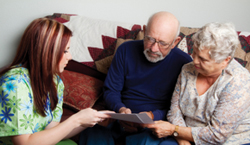
Communication is the foundation upon which relationships are built. Early communication with patients and families will increase trust, knowledge and satisfaction.
Effectively communicating with patients and families will help the palliative care team understand the needs and wishes of all involved. When communicating with patients and families about series illness, healthcare professionals should remember to give attention to the environment and the physical comfort of all concerned. Privacy is of the utmost importance. Therefore when having conversations about needs and wishes it is important to consider where these conversations are taking place. Some healthcare facilities have designated rooms for discussions that often times are painful and difficult. Many patients, however, prefer to stay in their own bed.
The palliative care team will prepare for the meeting with the patient, family and healthcare providers by first consulting with the patient's primary clinician, reviewing the patient's chart and determining the objective of the meeting. The team also will examine what has occurred so far and what the patient and family has been told about the patient's condition. There are many scripts and communication models that the palliative care team may utilize for the meeting. The "ASCEND" mnemonic, developed by Dr. Karen Knops1, is one model that is simple to use.
| A |
Anticipate (pre-meeting planning). This will include members of the palliative care team, healthcare providers and patient/family members. This may involve setting up and establishing the objective of the meeting. |
| S |
Summarize The patient/family summarize their understanding of the patient's condition and what the doctor has told them. |
| C |
Acknowledge concerns of patient/family |
| E |
Explore/Explain The goals of patient care, medical information, appropriate course of treatment. |
| N |
Next steps |
| D |
Document |
The palliative team also can indicate that the facility's Ethics Committee is an available resource to help the patient and family with communication and decision making.